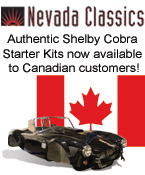 
 Main Menu
Main Menu
|
 Nevada Classics
Nevada Classics
|
 Advertise at CC
Advertise at CC
|
 February 2025
February 2025
|
| S |
M |
T |
W |
T |
F |
S |
| |
|
|
|
|
|
1 |
| 2 |
3 |
4 |
5 |
6 |
7 |
8 |
| 9 |
10 |
11 |
12 |
13 |
14 |
15 |
| 16 |
17 |
18 |
19 |
20 |
21 |
22 |
| 23 |
24 |
25 |
26 |
27 |
28 |
|
|
 CC Advertisers
CC Advertisers
|
|

10-24-2006, 06:59 AM
|
|
Banned

|
|
|
Join Date: Jul 2006
Cobra Make, Engine:
Posts: 162
|
|

 Not Ranked
Not Ranked

Quote:
|
Originally Posted by Anthony
I don't think that it's not because Ford didn't have the technology, but in the basic design of the engine. The "original" 427 had water jackets completely surrounding each cylinder, for even cooling. The Genesis has siamesed cylinders, that is no coolant pasing between the cylinders. If Ford wanted the 427 this way, I'm sure they could have cast it the same way as the Genesis. I'm not saying one way is better than the other.
|
First off, anyone boring ANY FE, be it an original 427SO or a more plebian 390, should have it sonic checked, by someone who knows what they're doing. And then, if you have cylinders that shouldn't be bored, don't.
Second off, the Pond block, in addition to having siamesed cylinders, has a bulged block around each cylinder that adds material (and strengh and weight) to the block. So strengthwise, it goes: bored-Original, Original, Genesis, Shelby, Pond.
Ford DID want it that way, at least initially. The FE was a thinwall casting, state of the art at the time, that weighed just enough but not too much. If you want an engine that was cast using 19th century theory, look to the 'elephant' hemi where the block was cast sooo thick that you could bore it probably an extra 1" per cylinder (JK). That was bad for real life usage in passenger cars, but great on a straight line drag strip.
Personally, I'd get a Pond, an aluminum Pond, a Genesis, an aluminum Genesis in that order of preference. You get the benefits of a design that has been updated for strength, that looks very close to the original, that will take all original parts as bolt-on's, and that are better than the originals. The Shelby just looks wrong. It might be 'better', it just looks wrong.

|
-
Advertising


10-24-2006, 01:01 PM
|
 |
CC Member

|
|
|
Join Date: Aug 2006
Location: Jersey Shore,
NJ
Cobra Make, Engine: Superformance SPF#2572, 427 S/O 2X4
Posts: 379
|
|

 Not Ranked
Not Ranked
Thanks to everyone for all of the input, as it is helping me get closer to making a final decision. What it has come down to is this; if the price were identical, which engine would you rather have, an original 428/FE or a new 427/FE Genesis?
__________________
Peace through superior firepower...or is it horsepower? Either way, more is always better!
|

10-24-2006, 02:18 PM
|
|
CC Member

|
|
|
Join Date: Feb 2006
Location: Kimball,
MI
Cobra Make, Engine:
Posts: 110
|
|

 Not Ranked
Not Ranked
Unless you are going for dead nuts originality, once you make the switch to a good quality aftermarket block you will never go back. My $.02
jack
|

10-24-2006, 02:18 PM
|
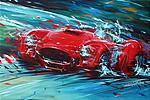 |
Senior Club Cobra Member

|
|
|
Join Date: Aug 2005
Location: Toronto, Canada,
Ont
Cobra Make, Engine: Shelby CSX 4995, Keith Craft built 427 SO
Posts: 1,168
|
|

 Not Ranked
Not Ranked
I don't think the price will be the same, but if it was I would still take the 427 FE. The 427 Keith Craft is building me is with the Pond cast block. Just my .02 worth! 
__________________
"The 427 Cobra is easily the highest performance car ever sold for street use. A decent 427 - not the worst, not the best, will go from zero to 100 mph and back down again to zero in less than 14 seconds. All thing considered, you can put together a pretty good argument that the 427 Cobra is the ultimate performance car, judged on any basis you want to name." Taken from; Corvette, The Sensuous American 
Last edited by 427SnakeSC; 10-24-2006 at 02:23 PM..
|

10-24-2006, 08:45 PM
|
|
CC Member

|
|
|
Join Date: May 2006
Location: St. Louisville,
Oh
Cobra Make, Engine: A&C 67 427 cobra SB
Posts: 2,445
|
|

 Not Ranked
Not Ranked

For what it is worth, I'm in the process of pulling apart a 95 4.6 DOHC modular. I know, I know, it not an FE, but bear with me a second here, as it becomes relevant. I haven't got it apart enough to measure the bores, but there are no ridge lines at the top. This engine has 105K miles on it. By feel I'm guessing less than 0.010 wear as I cannot feel anything anywhere, and you can still see the hone lines. Here is where it becomes relevant. This is an aluminum block with steel sleeves. I think the steel sleeves hold up much better than cast iron. This is a plus for a modern aluminum FE block, assuming they use steel sleeves rather than cast iron.
Additionally aluminum conducts heat better than cast iron, so cooling and even temps are much improved. However with the aluminum there is much more thermal expansion (think 4 times not sure). In my mind a large aluminum block push-rod engine almost has to have hydraulic lifters. With solids the valves would be mighty loose cold. Also the main bearing clearances change a bunch from cold to hot on an aluminum engine. Warm up is even more critical on an aluminum motor.
Hope that gives some food for thought on aluminum verses cast iron.

|

10-24-2006, 09:01 PM
|
|
CC Member

|
|
|
Join Date: May 2005
Cobra Make, Engine:
Posts: 136
|
|

 Not Ranked
Not Ranked
Not wanting to hijack this thread but wondering about a local motor - 427 side-oiler, "built right" and available for $8,000 Canadian.
This is a lot of money for this motor isn't it?
|

10-24-2006, 10:03 PM
|
 |
CC Member

|
|
|
Join Date: Nov 2003
Location: Fresno,
CA
Cobra Make, Engine: Shelby CSX 4766 (Vegas Built) with 482 Aluminum Pond motor
Posts: 814
|
|

 Not Ranked
Not Ranked
Quote:
|
Originally Posted by Eliems
Not wanting to hijack this thread but wondering about a local motor - 427 side-oiler, "built right" and available for $8,000 Canadian.
This is a lot of money for this motor isn't it?
|
Depends, If it really was rebuilt right! its not a lot of money.
But what does your phrase built right really mean?
__________________
Morgan LeBlanc
Fresno CA
|

10-24-2006, 10:20 PM
|
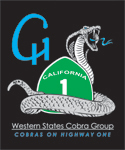 |
Senior Club Cobra Member

|
|
|
Join Date: Nov 1999
Location: Folsom,
CA
Cobra Make, Engine: ERA 623, 427 S/C Cobra. Ford FE 428 Cobra Jet, Ford Nascar TL 4speed - with a touch of raw; "less is more" theme
Posts: 3,884
|
|

 Not Ranked
Not Ranked
What's even more puzzling to me is the people who declare they MUST have a 1960s original 427 block vs. a new aftermarket FE block in their replica Cobra. 
__________________
Duane
Western States Cobra Group 1998-2016.
|

10-24-2006, 10:36 PM
|
 |
CC Member

|
|
|
Join Date: Nov 2003
Location: Fresno,
CA
Cobra Make, Engine: Shelby CSX 4766 (Vegas Built) with 482 Aluminum Pond motor
Posts: 814
|
|

 Not Ranked
Not Ranked
 Ouch
Ouch
Quote:
|
Originally Posted by decooney
What's even more puzzling to me is the people who declare they MUST have a 1960s original 427 block vs. a new aftermarket FE block in their replica Cobra.  |
Ernie, you still out there? The snake must have his tongue  
__________________
Morgan LeBlanc
Fresno CA
|

10-24-2006, 11:13 PM
|
|
CC Member

|
|
|
Join Date: Jun 2003
Cobra Make, Engine: ERA 427 w/496 Side Oiler, roller, dual quads
Posts: 417
|
|

 Not Ranked
Not Ranked

Quote:
|
Originally Posted by Anthony
I don't think that it's not because Ford didn't have the technology, but in the basic design of the engine. The "original" 427 had water jackets completely surrounding each cylinder, for even cooling. The Genesis has siamesed cylinders, that is no coolant pasing between the cylinders. If Ford wanted the 427 this way, I'm sure they could have cast it the same way as the Genesis. I'm not saying one way is better than the other.
|
You're right, Anthony. I used the wrong word. Substitute knowledge for technology. Ford (nor the other manufacturers) knew siamesed cylinders would work. To my knowledge, Chevy was the first to do it on the 400 smallblock. Another thought is how much metal must you have minimum around the siamesed bores for the process to work? Ford could have saved a lot of money by making the cylinder walls thicker. They scrapped a lot of 427 blocks because of core shift and the sand used for the casting was so thin between the bores it wouldn't always stay in place.
Dan
__________________
Do you know why they call it "PMS"? Because "Mad Cow Disease" was taken. --Unknown, presumed deceased
|

10-25-2006, 05:24 AM
|
|
CC Member

|
|
|
Join Date: Apr 1999
Location: cleveland,
OH
Cobra Make, Engine: CSX4000, 427
Posts: 1,999
|
|

 Not Ranked
Not Ranked

Quote:
|
Originally Posted by olddog
I'm in the process of pulling apart a 95 4.6 DOHC modular. I ...I haven't got it apart enough to measure the bores, but there are no ridge lines at the top. This engine has 105K miles on it. By feel I'm guessing less than 0.010 wear as I cannot feel anything anywhere, and you can still see the hone lines. Here is where it becomes relevant. This is an aluminum block with steel sleeves. I think the steel sleeves hold up much better than cast iron. This is a plus for a modern aluminum FE block, assuming they use steel sleeves rather than cast iron..
|
I think the sleeves are ductile iron. Although the cast iron of the sixties for the most part may leave alto to be desired, in addition to lighter weight, the real advantage is the ability to repair the block and easily change out a sleeve(s), although you can still sleeve an iron block.
Quote:
|
Originally Posted by olddog
Additionally aluminum conducts heat better than cast iron, so cooling and even temps are much improved. However with the aluminum there is much more thermal expansion (think 4 times not sure). In my mind a large aluminum block push-rod engine almost has to have hydraulic lifters. With solids the valves would be mighty loose cold..
|
Just the opposite, the valve lash is very tight when the engine is cold, about 0.013" for an all aluminum FE. Solids are not a problem.
Quote:
|
Originally Posted by Carnut427
Substitute knowledge for technology. Ford (nor the other manufacturers) knew siamesed cylinders would work. To my knowledge, Chevy was the first to do it on the 400 smallblock. Another thought is how much metal must you have minimum around the siamesed bores for the process to work? Ford could have saved a lot of money by making the cylinder walls thicker. They scrapped a lot of 427 blocks because of core shift and the sand used for the casting was so thin between the bores it wouldn't always stay in place.
|
I think the main reason why auto manufacturers didn't make siamesed cylinders is for even cooling, even expansion, maintaining a concentric cylinder bore for effective ring sealing, i.e.more HP. I would think that with any given engine displacement, it would be better to have an engine designed with cooling around the cylinders than not. As the 427 was made only for NASCAR, for 7 liter displacement limit, as was the subsequent Boss 429, 426 hemi, chevy 427, etc. they designed engines with big enough bore spacing to allow water jackets for an engine of 7 liter displacement. Obviously, with siamesed cylinders, you can take the bore out bigger, compromising cooling which may or may not be an issue.
__________________
"After jumping into an early lead, Miles pitted for no reason. He let the entire field go by before re-entering the race. The crowd was jumping up and down as he stunned the Chevrolet drivers by easily passing the entire field to finish second behind MacDonald's other team Cobra. The Corvette people were completely demoralized."
Last edited by Anthony; 10-25-2006 at 05:08 PM..
|

10-25-2006, 06:47 AM
|
|
Banned

|
|
|
Join Date: Jul 2006
Cobra Make, Engine:
Posts: 162
|
|

 Not Ranked
Not Ranked
because of GM's design, the 400 with siamesed cylinders had cooling issues. Steam pockets were created under the deck because there was no flow around the cylinders at that point.
supposedly, that is not an issue with the Genesis blocks.
everyone is implying that siamesed cylinders can be bored to the extreme of a .10 wall shared by two cylinders. Not so.
a siamesed cylinder works better generally because it is thicker overall, stiffer, less prone to distortion.
it IS connected to the next cylinder(s) along a line though. Heat these cylinders up, and constrained as they are by their neighboring cylinders, you'll get out-of-round distortion. bore these connected cylinders and you'll experience MORE of this out-of-round distortion than you would if the cylinders were free 360* around. So siamese cylinders CAN be good, just don't take all that metal as a free pass to bore the daylights out of them or you'll have ring seating (and other) problems like you wouldn't believe.
|

10-25-2006, 06:06 PM
|
|
CC Member

|
|
|
Join Date: Sep 2006
Cobra Make, Engine: No Cobra... yet!
Posts: 15
|
|

 Not Ranked
Not Ranked
NM at all, this time
Last edited by farmallmta; 10-25-2006 at 06:18 PM..
|

10-25-2006, 06:16 PM
|
|
CC Member

|
|
|
Join Date: Sep 2006
Cobra Make, Engine: No Cobra... yet!
Posts: 15
|
|

 Not Ranked
Not Ranked

Quote:
|
Originally Posted by Carnut427
Ford (nor the other manufacturers) knew siamesed cylinders would work. To my knowledge, Chevy was the first to do it on the 400 smallblock. Dan
|
A little bit of drift from the topic, perhaps, but the Bowtie Bozos yet again get credit for an idea they merely copied from their betters. Chebby was NOT the first to utilize cylinder siamesing. All manufacturers were familiar with the design but for various reasons having to do with cost and warranty considerations shied away from the concept for the most part.
While various truck and heavy duty engines earlier had used siamesed cylinder design for low RPM applications, the Hudson 308 inline 6cyl developed in the late '40's and first installed in the Hornet line in '51 had siamesed cylinders and was intended to be capable of all-out sustained high RPM racing. This application most closely tracks our interest in this forum and is probably one of the first American applications of cylinder siamesing as we would use it.
The Hudson 308 engine was a bored version of the 262ci engine which required strengthening as the original design limitations were exceeded. The high chromium content of the block alloy minimized cracking of the siamesed cylinders under ordinary use conditions but an overheated block would occasionally crack under severe (race) use. Despite this, the Hornet was THE car to beat in NASCAR (a brutally harsh racing environment in those crude dirt track days) from '51 up into '54. Anyway, the best overhead valve V8-equipped Olds and Mopars found it very difficult to beat the 308ci (FLATHEAD no less) 6 banger in a Hudson Hornet. The other marques (ESPECIALLY Chebby) were completely outclassed and not even close to being serious contenders.
Doc (The Fabulous Hudson Hornet) Hudson sends his kind regards! 

|

10-25-2006, 06:29 PM
|
 |
CC Member

|
|
|
Join Date: Mar 2005
Location: Crowley,
LA
Cobra Make, Engine: Findling 001 - starting scratch build
Posts: 206
|
|

 Not Ranked
Not Ranked
 Disappearing marques.....
Disappearing marques.....
Quote:
|
Originally Posted by farmallmta
The Hudson 308 engine was a bored version of the 262ci engine which required strengthening as the original design limitations were exceeded. The high chromium content of the block alloy minimized cracking of the siamesed cylinders under ordinary use conditions but an overheated block would occasionally crack under severe (race) use. Despite this, the Hornet was THE car to beat in NASCAR (a brutally harsh racing environment in those crude dirt track days) from '51 up into '54. Anyway, the best overhead valve V8-equipped Olds and Mopars found it very difficult to beat the 308ci (FLATHEAD no less) 6 banger in a Hudson Hornet. The other marques (ESPECIALLY Chebby) were completely outclassed and not even close to being serious contenders.
|
Despite all their success in NASCAR, Hudson disappeared as a marque in
1957. Hudson might have outclassed the other marques on the racetrack,
but they certainly didn't outclass them in the showroom.
....Fred |

10-25-2006, 07:59 PM
|
 |
CC Member

|
|
|
Join Date: Jun 2003
Location: Freedomia,,
Il
Cobra Make, Engine: Coupe,Blue w/white stripes SB; Roadster, Blue w/white stripes BB w/2-4s; SPF installer/Hot Rod-Custom Car builder
Posts: 1,376
|
|

 Not Ranked
Not Ranked
Quote:
|
Originally Posted by olddog
I haven't got it apart enough to measure the bores, but there are no ridge lines at the top. This engine has 105K miles on it. By feel I'm guessing less than 0.010 wear as I cannot feel anything anywhere, and you can still see the hone lines. Here is where it becomes relevant. This is an aluminum block with steel sleeves. I think the steel sleeves hold up much better than cast iron. This is a plus for a modern aluminum FE block, assuming they use steel sleeves rather than cast iron.
|
I think you are coming to a conslusion that is waaay off. Since the introduction of low tension piston rings in mass production in the 80s(created as a way to elevate CAFE) cylinder wear is much less than it once was. I have pulled down several 5.0 roller motors with over 120K and they have minimal wear also. I think the reduction in wear you are seeing is a result of the ring design and has nothing at all to do with the block metallurgy.
__________________
WDZ
|

10-25-2006, 09:10 PM
|
|
CC Member

|
|
|
Join Date: Sep 2006
Cobra Make, Engine: No Cobra... yet!
Posts: 15
|
|

 Not Ranked
Not Ranked

Quote:
|
Originally Posted by ffindling
Despite all their success in NASCAR, Hudson disappeared as a marque in
1957. Hudson might have outclassed the other marques on the racetrack,
but they certainly didn't outclass them in the showroom.
....Fred
|
Interesting point, Fred. Actually, Hudson truly died in '54 (I happen to own one of the very last true Hudson Hornets, made in the last week before the line shut down for good in '54)... the Hudson nameplate simply got slapped on Nash cars until '57, except that the 308 did soldier on for a while past '54. Just goes to show that a marque with recognized "Milestone" stepdown design, topnotch performance and--for the times--safety as well as some of the most beautiful body and interior styling of the day simply couldn't compete with the low costs, hucksterism, and market power of Great Monster. 
The fact remains, if I may nudge us back to the topic of siamesed engine cylinders, that successful siamesing of cylinders in a high performance engine pushing or exceeding original design limitations WAS done well before Ford or GM would have considered it in subsequent DECADES! 

|

10-25-2006, 11:47 PM
|
 |
Senior Club Cobra Member

|
|
|
Join Date: Feb 2004
Location: Sacramento,
CA
Cobra Make, Engine: Shelby CSX4795 (Sold)
Posts: 1,542
|
|

 Not Ranked
Not Ranked
 Bragging rights!
Bragging rights!
I put a 66' 427fe in my car for the bragging rights.
I could have built any number of other engine combo's for less $$.
But just look at this and imagine saying "Yes, it's an original 1966 FORD 427fe side oiler"!

I did, and pony'ed up for the bragging rights! 
jdog
P.S. You can't take it with you, might as well enjoy it while your still here! 
__________________
"If you can't run with the BIG DOGS, stay under the porch!"
Last edited by jdog; 10-26-2006 at 06:04 PM..
|

10-26-2006, 06:21 AM
|
|
CC Member

|
|
|
Join Date: Mar 2003
Cobra Make, Engine:
Posts: 1,514
|
|

 Not Ranked
Not Ranked
Jdogy - ...and then you put THAT air cleaner on it.  Contradictory comes to mind. Yes, it still does look nice though.  |

10-26-2006, 07:28 AM
|
|
Banned

|
|
|
Join Date: Jul 2006
Cobra Make, Engine:
Posts: 162
|
|

 Not Ranked
Not Ranked
Quote:
|
Originally Posted by Cracker
Jdogy - ...and then you put THAT air cleaner on it.  Contradictory comes to mind. Yes, it still does look nice though.  |
and those anodized fittings are certainly NOS.
have to wonder about the internals...original pistons? rods? valves? cam? water pump?
originality is such a loose word.
getting back on track, do the Genesis block. highly recommend using a builder that's built a couple of them before. |
 Posting Rules
Posting Rules
|
You may not post new threads
You may not post replies
You may not post attachments
You may not edit your posts
HTML code is Off
|
|
|
All times are GMT -7. The time now is 10:36 PM.
|




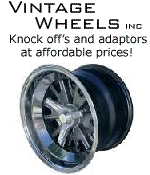
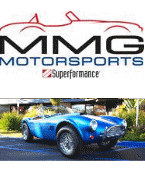


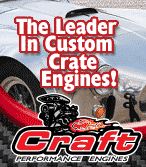

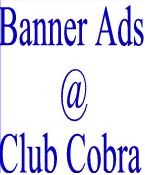


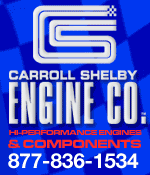














 Contradictory comes to mind. Yes, it still does look nice though.
Contradictory comes to mind. Yes, it still does look nice though. Linear Mode
Linear Mode



